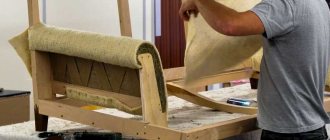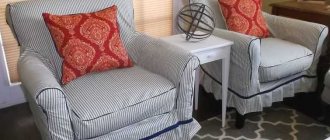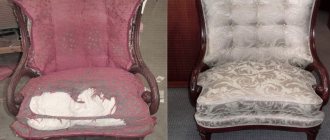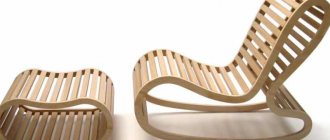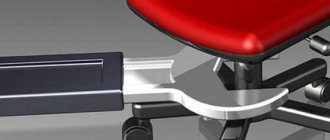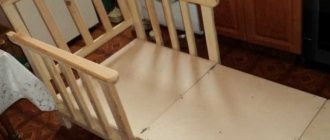0
13150
Replacing upholstery is a budget-friendly way to update upholstered furniture. It is the fabric that first loses its attractive appearance, while the frame is still strong and can serve for many years. If you wish, you can do the work yourself. It is worth carefully studying the information on how to reupholster a chair with your own hands step by step, so that the effort expended is justified, and the product begins to look like new. The algorithm is simple and requires only strict adherence to consistency and accuracy.
Advantages and disadvantages of chair reupholstery
Before you update an old chair with your own hands, it is worth understanding all the pros and cons that the owner of such a piece of furniture receives.
If you are good at working with your hands and have a rich imagination, reupholstering a chair with your own hands will not be difficult, especially if you follow the instructions.
The positives include:
- For little money you can get a completely new, attractive looking product.
- When there is no financial opportunity, you can update the furniture, sparing the family budget.
- You can practice working with your hands, perhaps after this you will have a desire to make things and repair them yourself.
Disadvantages:
- You won't be able to buy completely new furniture this way. Therefore, it is impossible to talk about updating the interior style in this case.
- If you act ineptly, you can damage the product. And then you will have to make even greater efforts to restore it.
Furniture restoration means restoring not only its functionality, but also its appearance.
Perhaps restoration, based on its pros and cons, looks like a really winning move. Therefore, why not try to do it yourself. To do this, you first need to prepare the tools and buy fabric that you will like in appearance and will suit the interior. At the same time, do not forget to take into account the class that will allow it to serve for a long time in terms of its mechanical characteristics, and not break after a short period of use.
Such a thing will definitely attract the attention of guests and will decorate your interior.
Selection of upholstery material and filling
Before reupholstering a chair, you will have to study some information about what exactly to use when restoring a chair or armchair. Please note that you can use not only the materials listed in this paragraph. We have described the most common, synthetic, inexpensive, with acceptable characteristics. If desired or necessary, you can use natural analogues - copra in mats or rolls, batting, dried sea grass, horsehair, burlap and other materials that are exotic today and once traditional.
Most common materials
What materials are needed to reupholster a chair?
When restoring a chair or armchair, foam rubber or polyurethane foam (PPU) is used for the soft part. We are talking about foamed polyurethane foam, not sheet. There is also furniture latex. It and polyurethane foam differ from foam rubber to the touch. They are more like rubber (latex is generally like rubber); when stretched/compressed, they tend to return to their previous shape.
To be soft enough, the density of these materials should be 30-35 kg/m³. Foam rubber and polyurethane foam are sold in large sheets - the minimum size is 1*2 meters. So that's enough for more than one chair. Latex is usually available in some standard sizes, but is most often made to order.
Different thickness, density, rigidity, different manufacturing technologies
What is better to use for upholstering chairs - foam rubber, latex or polyurethane foam (PPU)? If we talk about quality and durability, then latex or polyurethane foam is better. They will last up to ten years or more without signs of wear, they absorb better and wear out less. The best of this pair is latex, but it is much more expensive than even polyurethane foam, not to mention foam rubber. Therefore, if you are on a limited budget, choose foam rubber. If durability is important - polyurethane foam or latex.
Now on the thickness of these materials. For the back, a thickness of 3-5 cm of foam rubber/PPU/latex is sufficient, depending on the degree of desired softness/hardness, but for the seat it is better to use materials with a thickness of 7-8 cm or more. If the base is solid - made of plywood, without springs or tapes - a thickness of 10 cm is needed. Otherwise the base will be felt.
The three most common materials are foam rubber, polyurethane foam and latex.
A padding polyester is laid on top of the foam rubber. Its thickness is small - 1 cm in a free state or so. It’s easier to navigate by density: 150-200 g/m². This layer is needed so that the foam/PPU/latex rubs less. This way, restored upholstered furniture will last longer.
If you want the chair or armchair you have reupholstered to last longer, another layer of spunbond is stretched over the padding polyester - this is a non-woven material made from a polymer melt using a spunbond method. Spunbond costs very little, but significantly extends the life of the seat. This layer is found in expensive furniture and increases durability (foam rubber/sintepon does not rub) and comfort of use (upholstery fabric does not fidget). A possible disadvantage is the accumulation of static electricity. But this is observed only when natural wool or silk is used in upholstery.
How to cut and fasten
The foam is cut to fit the size of the seat. The easiest way is to make a template at the initial stage: attach a sheet of cardboard to the seat, trace it and cut it out. This template will be needed more than once, so it’s better to make it.
It’s better to make a template right away, especially if you will be dragging several identical chairs
We cut out foam rubber and padding polyester strictly according to the template. In some cases, it is worth making it wider and longer by 3-5 mm so as not to feel the edges of the base. The cut foam rubber is glued to the base using furniture glue. There is a special glue in a can for foam rubber. It is more convenient to use, but it is not easy to find everywhere.
The padding polyester is laid on top - one side is more “rough”, so we place it on the foam rubber/PPU/latex, level it and smooth it with our hands. After this, it is problematic to separate the laid layers (you can try). If this method does not seem reliable enough to you, you can glue the connection by applying a mesh of suitable universal glue or the same glue for foam rubber.
Latex is usually made to order, so the edges are rounded for greater convenience.
One point: if the base of the chair is not rigid - springs, tapes, a snake - the glue you should use is not the one that forms a hard crust after drying, but the one that remains elastic.
If you decide to also use spunbond, it must be cut out with a margin, attached with staples to the base, evenly straightened and stretched. You should not pull too hard - the material is non-woven and is easily damaged. It just needs to lie without folds. Carefully trim the excess to the level of the chair/chair frame.
What materials and tools are needed for reupholstery?
As tools for reupholstering, you need to prepare:
- Furniture stapler or staples for fixing the material to the base.
- Special tools that will allow you to disassemble and reassemble the chair. This includes hammers, wrenches, pliers and nail pullers.
- A stationery knife or a sharp thin hacksaw.
- Sewing machine for processing fabric. If it is not there, then you will have to use a needle and thread, which will require much more time and effort.
- Chalk for tailor's work.
- Sharp scissors with long blades that can cut through thick material.
When choosing materials for such work, you should stock up on:
- Dense foam rubber of appropriate thickness.
- The material that can be used is chenille, flock, matting of different compositions, nubuck (natural and artificial), tapestry or jacquard fabrics, leather or eco-leather. The choice depends on individual preferences, the overall style of the interior, and the effect you want to get from the chair.
When choosing a finishing material, first of all, you need to pay attention to how to reupholster the chair, as well as strength and wear resistance indicators.
Height adjustment
We figured out how to disassemble a computer chair, but how to determine its height? If the seat height is not adjusted, problems in the lumbar region or pinched nerve endings may soon occur. To avoid this, you need to constantly check the seat height and adjust it correctly.
To lower the chair, you need to pull the lower lever. After which the computer seat will smoothly lower or rise. The optimal height is selected taking into account the individual characteristics of the chair and desk. It is recommended that the height of the armrests coincide with the height of the table.
Selecting and preparing fabric for upholstery
Of course, when choosing material for upholstering a chair, many rely solely on their own taste. When considering fabric or leather, from the point of view of upholstery material, they evaluate the texture, color scheme, and the presence or absence of a print. But at the same time, many people forget that they will have to upholster furniture with this fabric. But you will have to sit on the chair and subject it to mechanical stress and additional friction.
If you have pets, such as a dog or cat, flock is perfect. This material is resistant to scratches and holes from sharp claws.
It is for this reason that the upholstery must meet the following conditions:
- You can only cover it with thick material. Thin fabric will quickly break through and the whole manipulation will have to be redone.
- Strength is another important parameter. There are materials that have fibers that cannot be broken. Therefore, it is worth choosing fabric or leather materials specially created for furniture work.
- Another important factor is practicality. Remember that furniture sometimes requires cleaning. Therefore, it is better if the fabric can be easily cleaned with a vacuum cleaner, brush or damp cloth.
Chair upholstery with fabric
The back must be cut from the first meter of fabric, and the seat from what remains. Try on a piece of fabric to the chair so as not to make mistakes in the measurements.
The cover is attached to the frame with a stapler; if you cannot sew the covers yourself, it is best to contact a sewing workshop. The tension should be done in your direction, when the cover is nailed to the frame, the distance between the staples or nails should be no more than four centimeters.
Note!
- DIY book shelf: instructions on how to make, assembly diagram, placement recommendations (120 photo ideas)
DIY children's furniture: step-by-step instructions, diagrams, choosing the size and color of furniture, photos of the best ideas
How to make a stool with your own hands from wood - step-by-step instructions, drawings, dimensions, photos
When doing work, you need to be careful. It is worth remembering that it is important to have properly sewn covers of suitable sizes, and then the reupholstery will certainly work out.
How to upholster an old chair with your own hands
Before you reupholster the chair with your own hands, you need to understand all the steps step by step. The sequence of manipulations is important, since their violation will lead to the inability to implement this process. Here are the step-by-step instructions you need to pay attention to.
Having prepared the entire set of tools, you can begin to disassemble the old chair.
Disassembling the chair
First you need to disassemble the chair. This is done as follows:
- First, all elements are removed, which can be removed quite easily. These could be armrests.
- Then the chair is placed in a horizontal position with the seat up. You need to get to the bottom and remove the legs.
- After which the fasteners at the back and base are removed. Most often, upholstery and soft foam are fixed with staples around the perimeter. They are simply carefully pulled out by prying them off with a knife or thin screwdriver.
- Then all other elements are untwisted. Most often they are fixed with screws, so you will have to work with a screwdriver.
It is important to do everything with extreme caution, since the upholstery will be needed to cut new fabric.
Remember that when disassembling it is desirable to maintain the integrity of the fabric. Don't tear it, it can be useful for making a pattern in the future.
Fabric cutting
At the second stage, it is advisable to cut the fabric. At this stage of repair, you can either take measurements yourself from furniture elements, or use existing old pieces of fabric.
You need to take the fabric you plan to use to cover the furniture and wash it. Remember that this is only for woven materials. Leather, eco-leather, suede and other natural materials of animal origin or their imitation are not subject to such manipulations. Otherwise, you can simply ruin them.
It is advisable to take the canvas 10% longer than the required length.
It is important to wash and iron to allow the fabric to shrink. After this, dry and iron.
Remember that exposure to temperature will allow the fabric to take its final size. Since in some cases, especially when using natural fibers, they are able to reduce their overall dimensions.
After this, spread the fabric on the floor, face down. Use a pattern drawn on paper or old pieces of fabric. A pattern on paper will make the work more accurate and precise.
We place the old upholstery parts on the fabric, outline them with tailor's chalk, leaving a small margin.
Then, using a tailor's chalk, draw the outlines. Remember that you need to cut it along them, taking into account an increase of 1 centimeter on all sides.
The cutting stage ends here.
Upholstery and assembly of the chair
After this, we proceed directly to the work of re-upholstering. The step-by-step instructions are as follows:
- You need to cover furniture by first laying a layer of foam rubber on the frame base. Therefore, it is necessary to cut it out with a sharp utility knife or blade. The dimensions must clearly correspond to the shape of the seat and backrest.
- Foam rubber is laid out on the base.
- The fabric is placed on top with the right side up. Holding it with one hand, you need to place the element on the floor on the fabric. Carefully pulling up the edges of the fabric and bringing them behind the end part, pull the furniture using a furniture stapler. It is important to push the staples in as often as possible so that the material does not sag or stretch.
- After the seat and back are covered with material, it is necessary to reassemble the product in the reverse order.
- Most often, the legs are attached to the seat first. Then the back is fixed.
- At the last stage, the side elements and armrests are fixed.
Having secured it, we stretch the fabric from the front side and check for the absence of folds.
If everything is in order, we tighten it and fasten the remaining sides. Remember that assembly must be done carefully so that all connections securely and firmly fix the parts together. Otherwise, the product may become loose quite quickly and will have to be tightened.
The final result will definitely pay for all the reupholstery efforts and will delight you for a long time.
Step-by-step instruction
The process of replacing upholstery consists of several operations: disassembling furniture, taking measurements of parts, creating a pattern, cutting material, covering and assembly. It is important to take into account the specifics of the selected fabric and work with it in accordance with the recommendations. Instructions for reupholstering a chair at home with a detailed description of each step will help you do everything correctly.
Disassembling the product
Before upholstering an old chair with your own hands, you need to disassemble it into individual elements. Most models have a wooden frame, consisting of a base seat, armrests, and backrest. Procedure:
- Remove all removable elements and decor (cases, pillows).
- Place the chair on its back to allow access to the bottom.
- Remove the legs.
- Remove the fasteners securing the backrest to the base. Unscrew the screws with a screwdriver and pry out the nails with a suitable tool.
- Remove the old staples around the perimeter of the plywood bottom.
- Pull out the bottom.
- Find and unscrew the screws holding the armrests.
After dismantling the remaining staples, carefully remove the fabric, being careful not to damage it - it will simplify the creation of a pattern for the new upholstery. Each detail must be signed, marking where the top is and where the bottom is. Before disassembling, it is recommended to take photographs of the product from different angles, so that later there will be no difficulties with assembly.
Self-upholstery of chairs can be combined with restoration of the product. It is necessary to assess the condition of the upholstery and frame. If the bolts become loose during operation, they are tightened and the nails are driven in until they stop. Yellowed, stained or severely deformed foam rubber must be replaced with new one. If the filler is in good condition, you can leave it or add a layer of new one on top.
Before reupholstering the chair with fabric, the frame is cleaned of dust, if necessary, damaged fittings are replaced and covered with a protective compound. Wooden elements that are not hidden by textile material (legs, armrests) are cleaned of the old varnish layer using a metal brush, and sanded first with coarse-grained and then fine sandpaper. Cover with stain, varnish or paint.
Cutting fabric
You should buy fabric by measuring each element with a measuring tape or measuring old removed upholstery after disassembling the furniture. Add 10% to the final value and purchase a piece of the resulting length. Before you reupholster the chair yourself, you need to accurately cut the material. This can be done in 2 ways: use old upholstery or build a new pattern using newspapers, leftover wallpaper, tracing paper or large sheets of paper.
When using removed upholstery, lay the new fabric face down on the floor or other flat surface. All parts of the old covers are distributed on it, taking into account the shared thread. If the material has a pattern, the elements are placed so that the pattern matches. On fluffy fabric, the parts should lie so that the thick fluff is directed downwards. Use chalk or soap to outline the contours of the pattern and make seam allowances of 5-7 cm.
The second method is more difficult - you need to apply paper to the part, form folds where they are required by the intended design. If necessary, chop off the edges with pins. Afterwards, outline the contours with a pencil, remove the paper, straighten it and cut it out along the drawn lines. Transfer to fabric using the same method as described above.
Complex parts consisting of several elements are sewn together by machine or by hand. It is recommended to process the edges of each workpiece with a hem seam. Form folds using pins and lay a stitch. If you plan to replace the filling when reupholstering a chair, then use foam rubber and batting. They can be purchased at construction and household departments. The batting will serve to fix the foam part, so it is cut using old covers or a self-made pattern, without making large seam allowances.
Reupholstering a leather chair is done a little differently. It is important to take into account the type of upholstery - the 1.5 mm thick material is elastic and easy to work with. Thicker options have almost no stretch; not every household sewing machine can sew them; you will need a special needle. Before upholstering the chair with leather, the blanks are applied to the product to make sure that they are cut correctly. If the part consists of 2 or more elements, first connect them with a clothespin or in another way that does not damage the material, and only then stitch it. If the stitching is done incorrectly, holes will remain on the surface after ripping.
Making patterns
Cutting out the details
Reupholstery and assembly
Simple and clear step-by-step instructions for reupholstering a chair:
- Work starts from the back. Apply foam rubber to the inside, cleaned of old filler. If the thickness of the material is large, the corners are cut to make the contours smooth.
- Batting is placed on top. Using a stapler, secure its edges to the back side of the back. The staples are placed every few centimeters, the material is slightly stretched, making sure that there are no distortions or wrinkles.
- Apply the cut fabric, align it, secure it with 4 staples, placing them on the sides. After, controlling the degree of tension, the material is gradually laid around the entire perimeter.
- All parts are sheathed in this way: seat, armrests.
- Place the remaining part on the back side of the back and secure with staples.
If you are upholstering chairs whose elements have a rounded shape, shallow notches should be made on the foam rubber in these places.
Upholstering the seat of a leather chair has its own characteristics. If it is necessary for the material to be stretched tightly, it is moistened before work. Wet leather stretches, so after drying it will return to its original size without folds.
When the upholstery on all parts has been replaced, they proceed to assembling the product. Repeat the same steps as during disassembly, but in reverse order. If difficulties arise, you should refer to photographs taken before restoration. Having learned how to reupholster a chair with your own hands step by step and following the given sequence of actions, you can update the furniture without great expense. The main thing is to work without haste, carefully cut the fabric and securely fasten the upholstery to the frame.
Replace synthetic winterizer or foam rubber
Attaching the new case
Secure the inner part of the seat with staples
Making holes for the legs in the case
The chair is ready
Master classes on upholstery of chairs
So, how to reupholster a chair with your own hands step by step is quite a troublesome task; it is important to take into account all the manipulations described above. At the same time, there are certain secrets that will help you perform the job at the highest level. Here are a few of them:
- If the chair stands on legs, then you must first cover the entire end part and the rear lower bar with fabric. Only after this the leg is fixed. In this case, you will need to carefully make a hole in the fabric. You should not leave the holes for the legs untightened at the time of reupholstery, as the fabric in this place will gradually stretch and tear.
- If the armrests are soft, then it is better to do the upholstery in this order - first the back, then the seat and only then the armrests. The elements are fixed to the frame in the same sequence. In this case, it will be possible to avoid distortions or so-called “bubbles” on the foam rubber. The work will look neat and high quality.
You will get a beautiful chair without extra costs.
Remember that these tips will help you upholster upholstered furniture - not just an armchair. If everything is implemented correctly, the result will be such that it will be impossible to distinguish it from the factory one.
Recommendations
To ensure that your computer chair lasts as long as possible, when planning reupholstery, you should choose the right type of material. You should focus on the following parameters:
material possibilities - fabrics can have a wide range of prices, so it is important to understand what you can count on;
interior design - when choosing the color, structure and print of the fabric, you need to take into account the interior of the room in which the furniture is located;
degree of use of the furniture - the choice of material should be made based on how often the chair will be used.
If a computer chair is completely upholstered with material, then it must be replaced everywhere so that the appearance of the product remains presentable. In addition to the seat and back, the armrests, which are also upholstered in fabric, often get very worn, so when purchasing material, it is worth including their dimensions in the size of the future canvas. The upholstery of the armrests is no different from working with other parts of the chair; they are immediately disassembled, then the old materials are replaced with new ones and the finished product is assembled. If the handles have wooden elements, it is recommended to update them by covering them with varnish or stain, which will make the appearance of the finished product more presentable.
To ensure that caring for the chair does not cause great difficulties, it is worth choosing not only durable and strong fabric. In addition, it should repel water and be easy to clean. If there is a question about choosing a color, it is better to buy a plain material, since the presence of a pattern may necessitate the selection of elements, which will increase the consumption of material, and accordingly, the cost and duration of the work.
An equally important point will be the choice of foam rubber, which is located under the upholstery. If its thickness or density is too small, then the comfort from using such a chair will be minimal. The choice of thickness should depend on the type of chair and the weight of the person who will sit on it. To increase the shock-absorbing properties and keep the soft parts of the chair elastic for as long as possible, you can lay a sheet of polyethylene foam on the base, which has greater elasticity and will not sag over time. By placing polyethylene, high-quality foam rubber and upholstery material, you can create a more comfortable computer chair than it was originally, and use it comfortably for a long time.
You can watch a detailed video about reupholstering a computer chair with your own hands below.
50 design options for chairs after restoration
How I reupholstered the chair
Three and a half years ago my chair broke. My beloved husband thought and thought and bought me a new one. Expensive! Great! Softening. Made from eco-leather (apparently young dermantine leather). With a rocking chair function and other bells and whistles.
For about a year and a half, the chair delighted us with its rugged office look, helped me rock my newborn daughter, and generally behaved perfectly.
The armrests were the first to fall off. Right one first. Then left. The left one fell off along with a piece of internal reinforcement. I sighed and discovered that without armrests it was even more comfortable - you could sit with your feet up in the chair.
Required set of tools
Necessary tools and materials for sewing a cover
Let's look at the set of tools needed to reupholster a chair. Prepare them in advance so as not to waste extra time.
A furniture stapler is the main working tool with which upholstery is attached to the frame. You can purchase it at any construction or hardware store at a low price. You need to buy special staples of the appropriate size for the stapler. It is better to take them with a reserve so that you do not have to interrupt the work process.
Foam rubber or batting - if the old filler has lost its former elasticity, it is necessary to replace it with a new one. Sold at a hardware or construction store.
Furniture filling – foam rubber
Batting for filling upholstered furniture
A flathead screwdriver or pry bar for removing old staples.
Minimum set of tools for furniture repair at home
A hammer, pliers, tailor's scissors, an adjustable wrench - all this will be needed to completely assemble and disassemble the chair.
Sewing machine, tailor's chalk or bar of soap, for sewing new upholstery.
You will need a sewing machine to sew a new chair cover.
A wire brush, coarse and fine sandpaper - for updating external wooden elements, as well as varnish or paint of the required shade.
How to update old furniture: ideas
Old chairs are often very strong and durable. But after a long period of use, they lose their attractive appearance. Do not rush to throw away such furniture, as it can be easily restored.
The technology for updating a chair depends, first of all, on its design. This can be done using several approaches:
- Pieces from the 60s can be restored simply by changing the upholstery.
This process is relatively simple. The main thing is to choose the right fabric style. Some designers recommend using several color shades that will fit into the overall interior. - Restoration of the external covering.
This approach involves changing the paint layer on wooden or metal surfaces. It is used for chairs made of rattan, wood, wicker and other natural products. This also includes restoration of natural or artificial leather (painting, cleaning, etc.). - Replacement of certain elements.
An old chair will look original if you replace the armrest with a product of a different shape. You can do the same with the legs or back. Here everything depends only on your imagination and capabilities.
